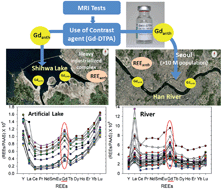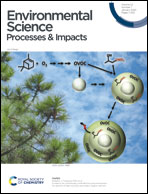Anthropogenic gadolinium in lakes and rivers near metrocities in Korea†
Abstract
We measured dissolved rare earth elements (REEs) in the water samples from Shihwa Lake (SL), which was assumed to be highly polluted, and in the downstream portion of the Han River (HR), which runs through Seoul, Korea. Among the investigated REEs, only gadolinium (Gd) was found to be significantly enhanced after REE concentrations were shale-normalized (SN). The calculated Gd anomaly (Gd/Gd* = 3 × GdSN/(SmSN + 2 × TbSN)) was about 1.5 ± 0.1 (n = 16) in SL and 1.6 ± 0.3 in the HR (n = 26) water relative to other types of natural water such as groundwater, seawater, and river water in uncontaminated areas (Gd/Gd* ∼ 1.2, n > 400). These significant Gd anomalies seem to be due to the inputs of anthropogenic Gd (Gdanth), especially from the use of Gd-based contrast agents for magnetic resonance imaging (MRI) tests from a number of hospitals and medical institutes surrounding our study areas. The amount of Gdanth was estimated to be 190 ± 80 g and 680 ± 360 kg Gd in SL and the HR (watersheds in our study area), respectively. The Gdanth flux to the Yellow Sea from the HR is estimated to be 530 ± 330 g Gd d−1. These results suggest that quantitative evaluation of anthropogenic REEs in natural waters near big cities is needed, because considerable amounts of REEs are now used by modern high-tech industries.



 Please wait while we load your content...
Please wait while we load your content...